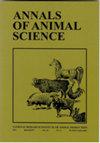Comprehensive analysis of runs of homozygosity and heterozygosity of Holstein cattle on the basis of medium and high density SNP panels and large population sample
IF 2.2
4区 农林科学
Q1 Veterinary
引用次数: 0
Abstract
Abstract This study reports runs of homozygosity (ROH) and heterozygosity (ROHet) distributed in a large population of Holstein cattle on the basis of two microarrays of medium (50k; 2163 animals; 54 609 SNPs) and high single nucleotide polymorphism (SNP) density (HD; 600 animals; 777 692 SNPs). To assess the inbreeding values of Holstein cattle, the ROH-based genomic inbreeding coefficient (F ROH ) was calculated. The comparison of SNP panels suggested that F ROH values above 4 Mb should be considered for panels of medium densities as a relatively reliable measure of inbreeding. Moreover, ROH hotspots and coldspots were identified and compared between the HD and 50k SNP panels and were carefully examined for association with production and functional traits. The obtained results pinpointed genomic regions presumably under selection pressure in Holstein cattle. The regions overlapped with a large number of genes, including GHR, GBF1, SUMF1, CCL28, NIM1K, U6, BTRC and FABP1 , many of which are involved in important Holstein cattle characteristics. We also found that some ROH hotspots and coldspots identified with the HD panel were not detected with the 50k panel, mainly because of insufficient SNP density in certain genomic regions. This suggests that using medium-density panels might not be the best choice when precise identification of ROH patterns is the main goal. In summary, in this work, we confirmed that a high-density SNP panel compared to a medium-density SNP panel allows for more precise identification of ROH patterns, especially in the case of short ROH that could be associated with ancestral inbreeding.在中高密度SNP图谱和大群体样本的基础上,对荷斯坦牛的纯合性和杂合性进行综合分析
摘要/ Abstract摘要:本研究报道了在大群体荷斯坦牛中,基于培养基(50k;2163动物;54 609个SNP)和高单核苷酸多态性(SNP)密度(HD;600动物;7777692个snp)。为了评价荷斯坦牛的近交价值,计算了基于ROH的基因组近交系数(froh)。SNP面板的比较表明,对于中等密度的面板,应考虑4 Mb以上的froh值作为近交的相对可靠的测量。此外,在HD和50k SNP面板之间确定并比较了ROH热点和冷点,并仔细检查了与生产和功能性状的关联。获得的结果确定了可能在选择压力下荷斯坦牛的基因组区域。这些区域与大量基因重叠,包括GHR、GBF1、SUMF1、CCL28、NIM1K、U6、BTRC和FABP1,其中许多与荷斯坦牛的重要特征有关。我们还发现,HD面板未检测到一些ROH热点和冷点,这主要是因为某些基因组区域的SNP密度不足。这表明,当精确识别ROH模式是主要目标时,使用中等密度的面板可能不是最佳选择。总之,在这项工作中,我们证实,与中等密度SNP面板相比,高密度SNP面板允许更精确地识别ROH模式,特别是在可能与祖先近交相关的短ROH的情况下。
本文章由计算机程序翻译,如有差异,请以英文原文为准。
求助全文
约1分钟内获得全文
求助全文
来源期刊

Annals of Animal Science
AGRICULTURE, DAIRY & ANIMAL SCIENCE-
CiteScore
3.80
自引率
5.30%
发文量
138
期刊介绍:
Annals of Animal Science accepts original papers and reviews from the different topics of animal science: genetic and farm animal breeding, the biology, physiology and reproduction of animals, animal nutrition and feedstuffs, environment, hygiene and animal production technology, quality of animal origin products, economics and the organization of animal production.
 求助内容:
求助内容: 应助结果提醒方式:
应助结果提醒方式:


